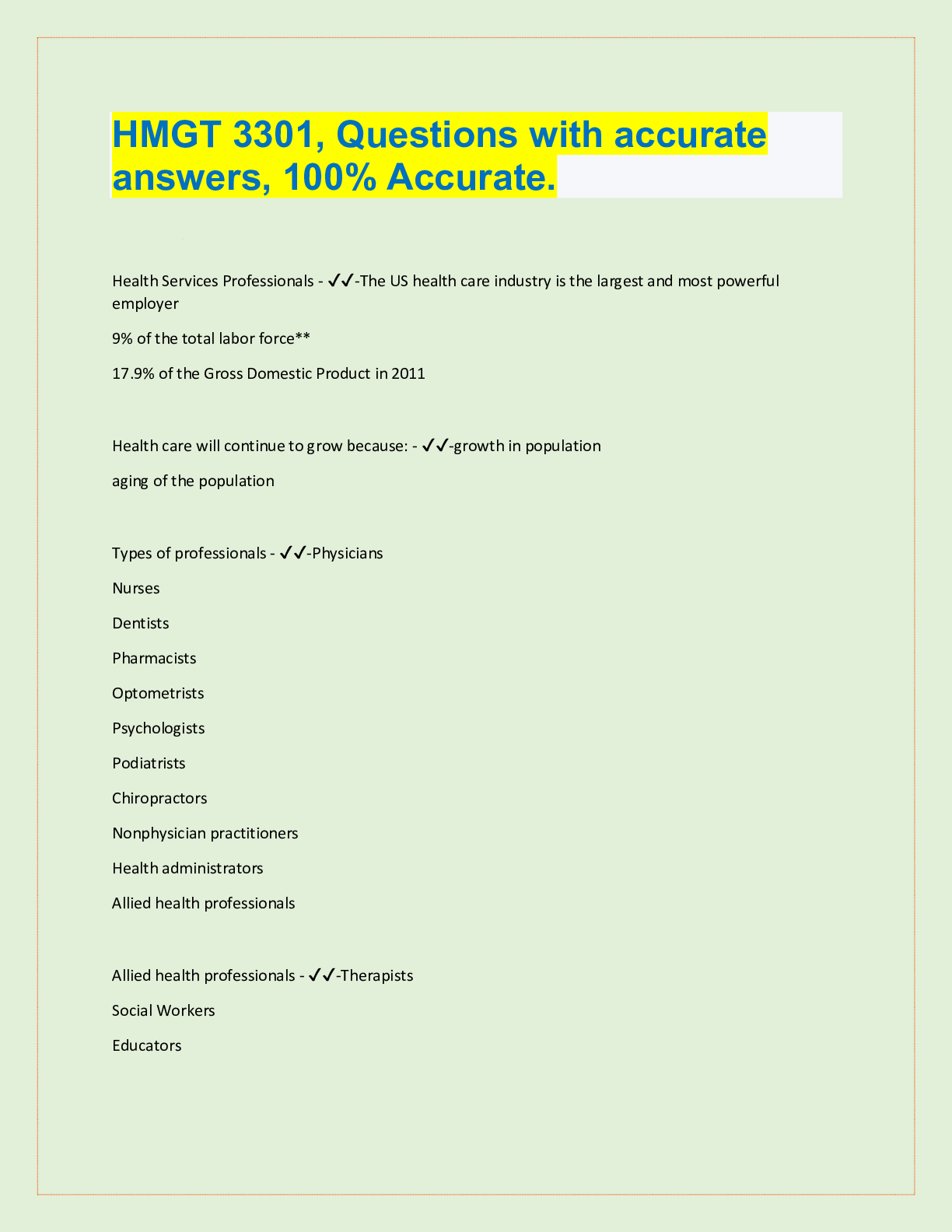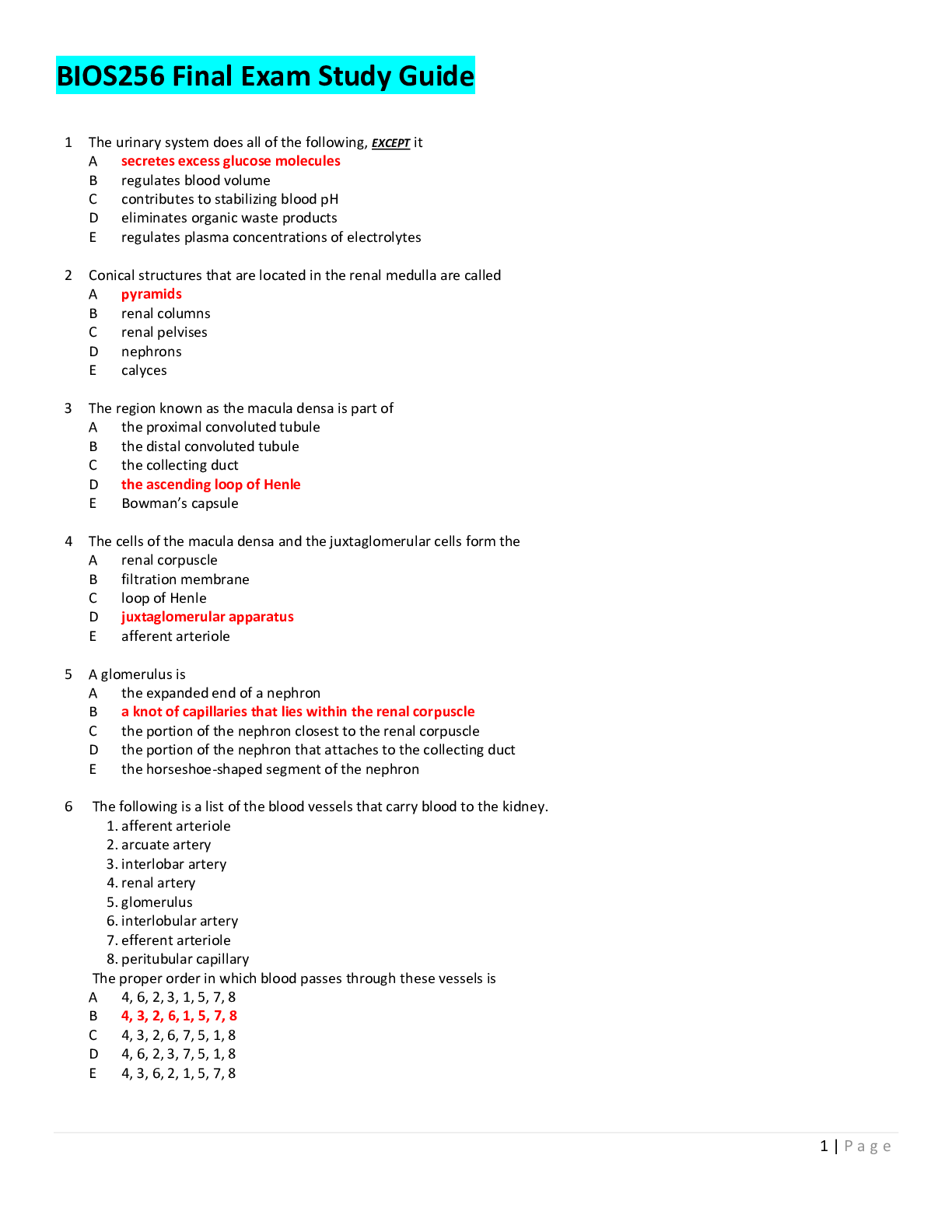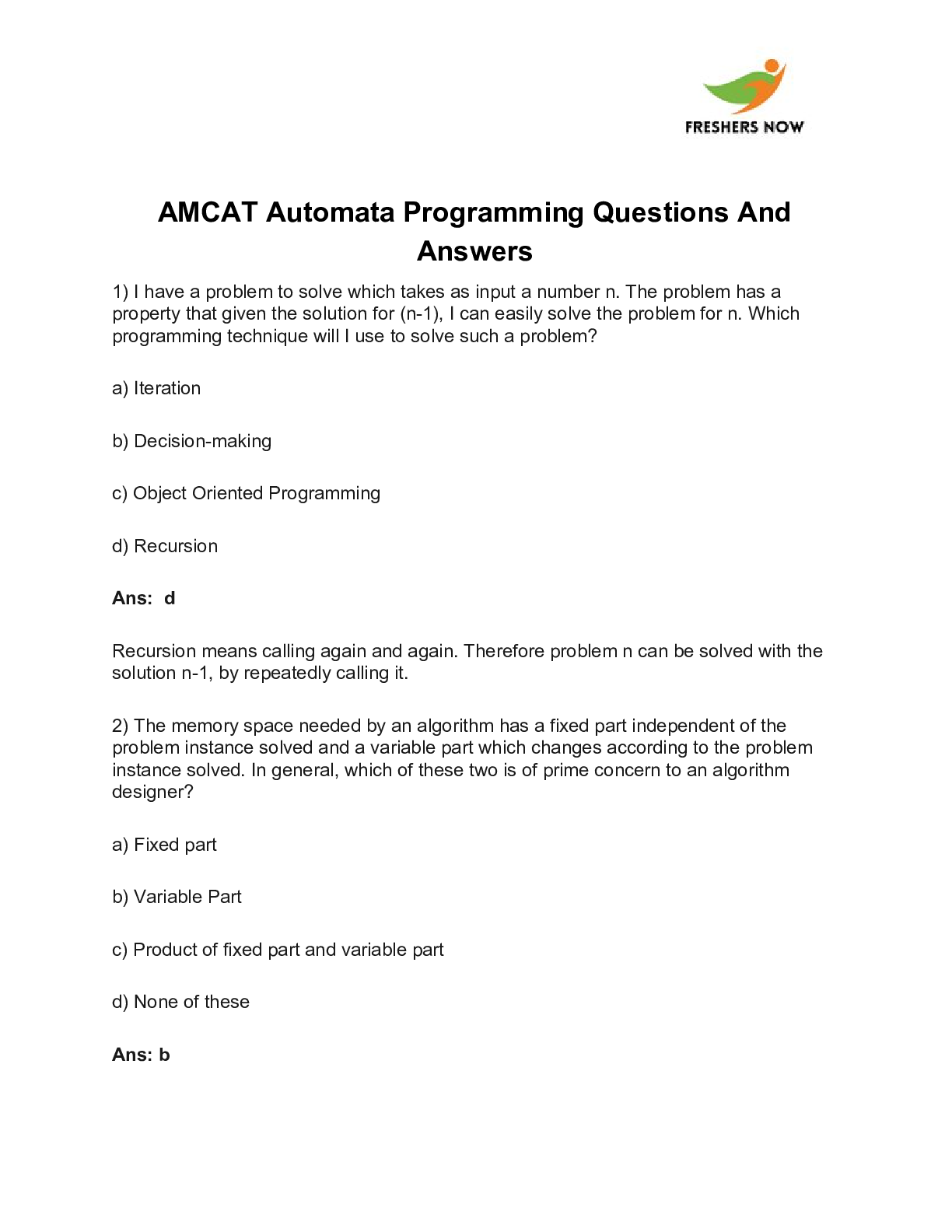Health Care > QUESTIONS & ANSWERS > HMGT 3301, Questions with accurate answers, 100% Accurate. Health Services Professionals - ✔✔-T (All)
HMGT 3301, Questions with accurate answers, 100% Accurate. Health Services Professionals - ✔✔-T
Document Content and Description Below
HMGT 3301, Questions with accurate answers, 100% Accurate. Health Services Professionals - ✔✔-The US health care industry is the largest and most powerful employer 9% of the total labor forc... e** 17.9% of the Gross Domestic Product in 2011 Health care will continue to grow because: - ✔✔-growth in population aging of the population Types of professionals - ✔✔-Physicians Nurses Dentists Pharmacists Optometrists Psychologists Podiatrists Chiropractors Nonphysician practitioners Health administrators Allied health professionals Allied health professionals - ✔✔-Therapists Social Workers Educators Health Personnel: Physicians - ✔✔-Play a central role in evaluating the patient States require licensure Graduate from an accredited medical school Pass licensure Complete residency, paid graduate medical education 2-6 years Number of active physicians increased See Table 4-2 Two types of physicians - ✔✔-MD - Doctor of Medicine Views medical treatment as active intervention to counter reaction to neutralize the effects of disease Most are Specialist DO - Doctor of Osteopathic Medicine Emphasizes the musculoskeletal system of the body such corrections of joints or tissue Most are Generalist Similarities and differences between physicians - ✔✔-Both use accepted methods of treatment (drugs, surgery) They differ in their philosophies and approach to medicine Health Services Professionals Work Places - ✔✔-Hospitals Managed Care Organizations Nursing Homes Mental health facilities Insurance firms Pharmaceutical Companies Outpatient Community Health Centers Mental Health Centers School Clinics Osteopathic Medicine - ✔✔-Practiced by DO's Stresses preventative medicine (i.e. diet, environment, other factors) Takes a holistic approach < 6% of physicians are osteopaths Physicians: Generalists and Specialists - ✔✔-Primary Care Physicians (Primary Care Provider) / Generalists Train in family medicine/general practice, general internal medicine and pediatrics Provide preventative medicine (i.e. exams, immunizations, mammographies, pap smears) Patients problems less severe and occur less frequently Specialists - ✔✔-Physicians in nonprimary care specialties Must seek certification in a medical specialization Takes more years of advanced residence training plus years of practice General Practitioner/Family Practice accounts for greatest proportion of ambulatory care visits Obstetrics/Gynecology: spent most hours in patient care per week highest in operating expense and malpractice premium Surgeons paid most (over $220,540 per year) Specialists Six Functional Groups: - ✔✔-1) Internal medicine 2) Medical 3) Obstetrics/Gynecology 4) Surgery 5) Hospital based radiology, anesthesiology, pathology 6) Psychiatry Primary Care - ✔✔-Different according to time, focus and scope of service to patients Primary Care Five Areas of Distinction: - ✔✔-1) the first contact to the health care system 2) in managed care, primary care providers are "gate-keepers" 3) primary care is longitudinal, they follow up in treatment and coordinate care (they serve as patient advisors and advocates) 4) focuses on the whole person (holistic, integrates) 5) spend much time in ambulatory care settings Specialty Care Five Areas of Distinction - ✔✔-1) Seen after patient has seen a General Practitioner usually 2) Requires referral from a Primary Care Provider to see a patient 3) Episodic, more focused and intense 4) Limited to an illness episode Deal with specific disease or body organs 5) Time spent in inpatient hospitals, using state-of art technology Issues in Medical Practices Consequences of Too Many Specialists: - ✔✔-High volume of intensive, expense and invasive procedures Rises health care costs Surgeries grew at two times the rate of population growth Health Services Professionals Employment - ✔✔-40.5% employed by hospitals 12.1% by nursing and personal care facilities 10.0% physician offices and clinics Nurses Reasons for Shortfall - ✔✔-sluggish wages low job satisfaction inadequate career mobility falling nursing enrollments demand from other alternative hospital sites Allied Health Professionals - ✔✔-Includes many health-related areas Constitutes 60% of U.S. health care workforce Two Broad Categories: 1) Technicians/assistants 2) Therapists/technologists Health Service Administrators - ✔✔-Employed at various levels of organizations Manage integrated delivery organizations that are complex MHA - Master in Health Administration MHSA - Master in Health Service Admin MBA - Master in Business Administration MPH - Master in Public Health MPA - Master in Public Administration/Affairs HSA Challenges - ✔✔-financing and payment structures work with decreasing levels of reimbursement pressure of uncompensated care high quality community health service demands by both public and private payers new policy developments changing competitive environment maintaining integrity What are the four principles of risk: - ✔✔-Risk is unpredictable Risk can be predicted with some accuracy in a large group Insurance can transfer risk from the individual to group through pooling of resources Losses are shared by all members List two reasons that Medicare is in jeopardy - ✔✔-Rising cost of delivering health care An aging population Shrinking workforce to support tax revenues What is a disadvantage of fee-for-service health care? - ✔✔-Provider induced demand, uncontrollable costs Why was there growth in Managed Care? - ✔✔-Flaws in fee for service Weakened economic position of providers Demand to control healthcare spending What is an ACO? - ✔✔-Accountable Care Organization Complexity of financing in the US: - ✔✔-many private plans many government programs many payment methods loss of insurance by many under the ACA government is expected to facilitate the purchase of insurance under the ACA Role and Scope of Health Care Financing - ✔✔-Financing influences supply of health care Production of health care services - capital expenditures, renovations, expansions New services and technology proliferate when they are covered by health insurance New models of health care organization may form Supply and distribution of health care professionals is affected Effect on total health care expenditures Financing and Cost Control - ✔✔-Expenditures are increased by Expansion of health insurance Increase in health insurance premiums Expenditures can be reduced by Restricting insurance (demand-side rationing) Restricting reimbursement to providers Having fewer specialists Spending less on R&D Direct control over utilization (supply-side rationi [Show More]
Last updated: 2 years ago
Preview 1 out of 33 pages

Buy this document to get the full access instantly
Instant Download Access after purchase
Buy NowInstant download
We Accept:

Also available in bundle (1)

HMGT 3301 EXAM BUNDLE, VERIFIED
HMGT 3301 EXAM 1 - Chapter 3, Question with accurate answers, 100% Accurate, rated A+.
By Topmark 2 years ago
$35
18
Reviews( 0 )
$11.00
Can't find what you want? Try our AI powered Search
Document information
Connected school, study & course
About the document
Uploaded On
Mar 14, 2023
Number of pages
33
Written in
Additional information
This document has been written for:
Uploaded
Mar 14, 2023
Downloads
0
Views
106

















, Question Answers, 100% Correct , Correct Answers.png)

.png)
, Question Answers, Correct , Correct Answers.png)




